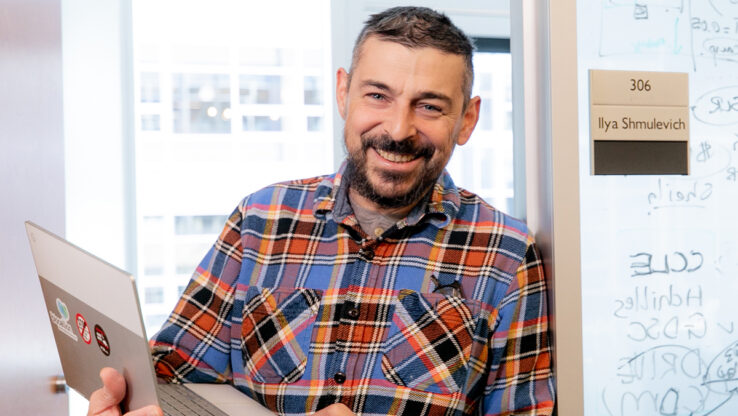Unveiling the Guerrilla Warfare Tactics of Mycobacterium Tuberculosis
 thorsson-shmulevich.isbscience.org/2020/04/28/unveiling-the-guerrilla-warfare-tactics-of-mtb/
thorsson-shmulevich.isbscience.org/2020/04/28/unveiling-the-guerrilla-warfare-tactics-of-mtb/
A team of ISB researchers published a story in the journal Cell Reports detailing the genetic programs that control dormancy in Mycobacterium tuberculosis (MTB). From left to right: Senior author and ISB Professor, Director and Senior Vice President Dr. Nitin Baliga, and co-lead authors Eliza Peterson (senior research scientist), Dr. Mario Arrieta-Ortiz (postdoctoral fellow), and Abrar Abidi (former Systems Research Scholars Program Fellow).
Tuberculosis (TB) is the world’s biggest infectious killer. In 2018, the disease killed an estimated 1.5 million people, and more than 10 million people contracted it, according to the World Health Organization. Around one quarter of the world’s population has latent TB — they are infected with Mycobacterium tuberculosis (MTB), the pathogen that causes TB, but are not yet sick with the disease or able to transmit it. This is because MTB can hide in a dormant state in human hosts for years, even decades, making it nearly impossible to eradicate. Until now, scientists have not fully understood how MTB can pull this off.
Researchers at Institute for Systems Biology (ISB) have discovered important insights into how MTB enters and eventually exits a dormant state, induced by an oxygen-starved environment within granulomas in the lungs of infected TB patients. These first-of-their-kind findings were published in the journal Cell Reports, and provide context and insights into how this deadly infectious pathogen uses guerrilla warfare tactics against the human host.
ISB researchers found that MTB adapts to stress from the host with physiological changes that allow it to survive and persist.
“We have found evidence of six distinct transcriptional states as MTB enters into and exits from dormancy in a hypoxic environment,” said Dr. Eliza Peterson, senior research scientist at ISB and co-lead author of the paper. “We have revealed dynamic expression patterns controlled by intricate and overlapping regulatory mechanisms.”
How MTB Enters ‘Stealth Mode’
To study how hypoxia affects MTB dormancy, researchers must expose the pathogen to controlled and gradual deprivation of oxygen in the lab, while collecting samples over several days to monitor its response at a molecular level — an extremely complex and challenging experiment to perform in a biosafety level 3 laboratory. However, until now, technologies to perform this experiment were limited, offering static, low-resolution snapshots that prevented the discovery of underlying mechanisms by which MTB transitioned in and out of dormancy. Peterson and co-lead author Abrar Abidi, both members of the research team that conducted this study, developed a new technology that allowed them to characterize in excruciating detail how genes within the pathogen are turned on or off in different oxygen levels.
“The novel instrumentation and methodology we developed allowed us for the first time to watch in slow motion the sequence of events through which MTB transitions in and out of a dormant state,” said Dr. Nitin Baliga, senior author on the paper and professor, director and senior vice president of ISB.
Over a five-day experiment in which oxygen level was exquisitely modulated, the ISB team discovered that three-fifths of all MTB genes changed in expression in varied temporal patterns as MTB entered into and exited from hypoxia. The large-scale gene expression changes demonstrated the importance of oxygen as a major force that controls MTB infection, enabling its successful evasion of the immune system and antibiotic attack. Dr. Mario Arrieta-Ortiz, also a co-lead author, noted that the research team “also uncovered the genetic programs that drive transitions between active growth and dormancy.”
Along with researchers from ISB’s Shmulevich Lab, the authors characterized dynamical properties of the regulatory programs that confer robustness, synchronization and coordination across various stages of MTB infection and reactivation. Interestingly, “we discovered from this analysis that the pathogen anticipates and prepares in advance to reinfect an immunocompromised host,” said Abidi.
Baliga added: “By understanding the genetic programs that allow MTB to go into stealth mode and opportunistically reinfect an immunocompromised individual, we will enable and accelerate the discovery of more effective drugs to treat TB.”






